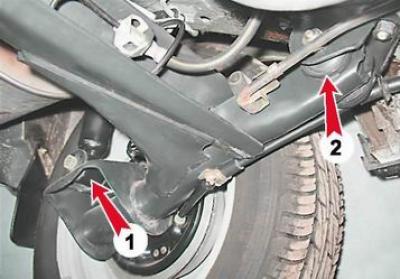You can assess the technical condition of the suspension while the car is moving. When driving at low speed on uneven roads, the suspension should work without knocks, squeaks and other extraneous sounds. After driving over an obstacle, the vehicle must not sway.
Tip: Suspension checks are best combined with tire and wheel bearing checks (see "Wheels, tires and hubs"). One-sided wear of the tire tread indicates deformation of the rear suspension beam.
To complete the work, you will need a viewing hole or overpass.
Execution sequence
1. We prepare the car for work (see "Preparing the car for maintenance and repair").
Recommendation: It is better to check the performance of shock absorbers after a long trip, while the working fluid in the shock absorbers has not cooled down.
2. Vigorously swing the back of the car body in a vertical direction. If, due to inertia, the body continues to oscillate (more than two: up and down), after it has stopped swinging, then one or both shock absorbers are faulty. To identify a faulty shock absorber, we repeat the test, applying efforts first on one side, and then on the other car.
Note: This test only detects defective shock absorbers. It is possible to check the effectiveness of vibration damping by shock absorbers only on a special stand.
3. We inspect the suspension shock absorbers - leakage of fluid from the shock absorbers is not allowed.
Recommendation: Shock absorbers should be replaced in pairs, even if the second rear shock absorber is in good condition.
4. Visually check the condition of the rubber-metal hinges of the shock absorbers (1) and levers of the rear axle beam (2).

Hinges with one-sided buckling of rubber, ruptures and cracks are replaceable (see relevant sections below).
5. We check the tightening of the nuts for fastening the suspension parts, if necessary, tighten them.
6. We examine the details of the suspension. Deformation and fatigue cracks in suspension parts are not allowed. We replace damaged parts.
